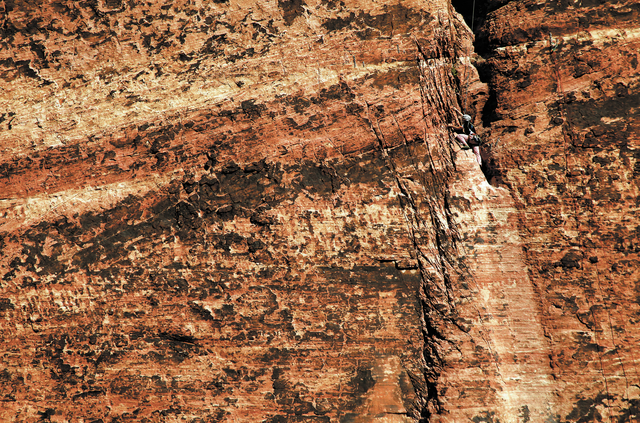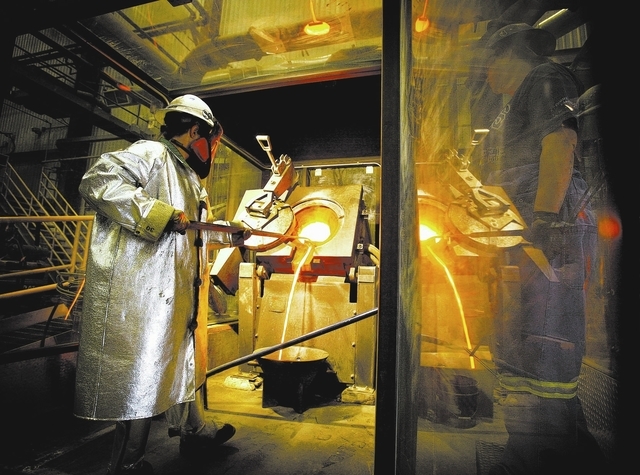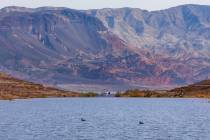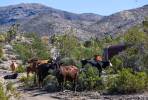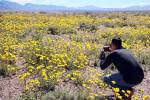Earthquakes and oceans shaped Nevada’s peaks, valleys
Statehood arrived half a heartbeat ago on Oct. 31, 1864, but Nevada truly got its start some 40 million years earlier.
That’s when geologic forces conspired to stretch the continent, allowing magma and super-heated liquid laden with gold to stream in and fill the cracks.
Those deposits eventually seeded many of the state’s early towns and fueled its young economy. Then they helped the state boom again starting in the 1960s with the discovery of another Cenozoic treasure trove: invisible gold.
“We’re blessed with an endowment of mineral resources, and gold is one of the biggest,” said Mike Visher, deputy administrator for the Nevada Division of Minerals.
Put another way: Geology built Nevada, and Nevada was built on geology.
PEAKS AND VALLEYS
Wanda Taylor is a professor of structure and tectonics in UNLV’s Department of Geoscience.
She said the same forces that produced the Carlin Trend and other Nevada gold deposits also created the state’s signature landscape feature.
Nevada is the most mountainous state in the nation, with so many distinct ranges that some say it is impossible to stand anywhere in the state without seeing some peak or another in the distance.
When viewed in satellite images, Nevada sports what look like zebra stripes running north to south. Geologists know it as the Basin and Range, a series of narrow mountain blocks separated by flat valleys formed as the Earth’s crust was stretched and broken by extensional faults.
The Basin and Range province extends north into Idaho and Oregon and south into Mexico, but nowhere is it more pronounced and uniform than in the 500-mile sweep from Utah’s Wasatch Front to the Sierras.
As author John McPhee describes it in “Annals of the Former World,” his 1999 Pulitzer Prize-winning work of creative nonfiction: “With Nevada these high, discrete, austere new ranges begin to come in waves, range after range after north-south range; basin, range; basin, range; a mile of height between basin and range.”
Each of those mountain and valley pairings exists because of at least one or two fault lines.
“This is why we’re interested in earthquakes,” Taylor said. “The landscape is active. It’s geology in action.”
As the crust extends, it thins and cracks, creating space for heat and molten rock from the Earth’s interior to rise toward the surface. In the Nevada of the comparatively recent geologic past, that helped produce something besides gold: volcanoes.
The state is dotted with the remnants of calderas and cinder cones, including one former volcano near the shore of Lake Mead that has been ripped in half and carried in opposite directions along an active fault over the past 12 million years or so.
Some of the largest volcanic eruptions anywhere on Earth occurred in Nevada, including one blast some 31 million years ago so powerful it buried portions of what is now the central part of the state beneath a layer of ash and crystals nearly one mile thick, Taylor said.
The continent began stretching some 50 million years ago, and it continues today.
The process eventually will rip the North American Plate apart, and an ocean will fill the hole the way the Red Sea is slowly expanding in the gap between Africa and the Arabian Peninsula.
“Thankfully, it will take a while,” Taylor said. “Tens of millions of years.”
All of this has happened before. If you go back far enough, almost everything has.
From roughly 500 million years ago until about 200 million years ago, Nevada was at the bottom of an ocean filled with bony fish and giant squids and patrolled by carnivorous marine reptiles the size of tractor-trailers.
Today their fossilized bones are displayed at Berlin-Ichthyosaur State Park in northern Nye County, where the remains of sea monsters are weathering from rocks now almost a mile-and-a-half above sea level.
AN INVISIBLE FORTUNE
Much of the state’s early population was drawn by the discovery of the Comstock Lode in 1859 and by gold and silver strikes in Central Nevada and copper in Eastern Nevada during the early 1900s.
Some prospectors who came west to join the booms crossed directly above one of the richest gold deposits on Earth, though they had no way of knowing it was there or how to extract it.
The gold that triggered Northern Nevada’s modern boom is microscopic, diffused ion by ion into a type of rock called pyrite, which you may know by its other name: fool’s gold.
To get at it, multinational mining companies carve man-made canyons and haul out the surrounding rock in 240-ton loads to be crushed, cooked and washed in chemicals.
“It really took some clever geologists to figure it out,” said UNLV geology professor Jean Cline.
Those men were Newmont Mining geologists John Livermore and J. Alan Coope. In 1961, they followed some geological clues to a promising deposit of microscopic gold that became the Carlin Mine and triggered a flurry of exploration that continues today.
“It’s what’s called invisible gold,” Cline said.
So far, almost 80 million ounces of it have been teased from the rocks of Northeastern Nevada.
Visher said Nevada produced more than 5.6 million ounces of gold in 2012. If our state were a country, it would have ranked fourth in the world for gold production last year.
Nevada has produced enough gold since 1859 to make 28 full-sized versions of the Statue of Liberty worth more than $270 billion at today’s price.
Cline said some gold and silver coins were minted recently in honor of Livermore, who died early this year at his home in Reno at age 94.
NEVADA’S OTHER TREASURES
Nevada’s impressive geology has also produced riches of a different sort.
One of Southern Nevada’s most popular tourist destinations is Red Rock Canyon National Conservation Area. Almost a million hikers, climbers and other outdoor enthusiasts flock there each year.
Geologists do, too.
During a recent survey that netted a roughly 220 million-year-old fossil at Spring Mountain Ranch State Park at Red Rock, UNLV paleontologist Josh Bonde pointed to the striped sandstone cliffs that loom above the park.
“You’re looking at the first two periods of the age of dinosaurs. You’re looking at it, and you’re standing on it,” he said. “You don’t get much more dramatic topography for work.”
At the eastern edge of the Las Vegas Valley, near a trash-strewn roadside pullout next to Frenchman Mountain, is the Great Unconformity. It represents a gap in the geologic record spanning about 1.3 billion years.
This humbling absence is only visible in a few places in North America. Some people hike to the bottom of the Grand Canyon just to touch the formation, but one of the easiest places in the world to see it is at the edge of a wash a few yards off Lake Mead Boulevard, one mile east of Hollywood Boulevard.
There, the geologic wonder appears as a line — a few feet long and tilted at a 50-degree angle — where rock formed 1.8 billion years ago touches rock formed 500 million years ago.
The Silver State is filled with similar surprises. Taylor said there is no place she would rather be with a rock hammer in hand. “Nevada is an incredible place to be a geologist and to learn about geology.”
Even if you don’t strike it rich.
Contact reporter Henry Brean at hbrean@reviewjournal.com or 702-383-0350. He is on Twitter at @RefriedBrean.



